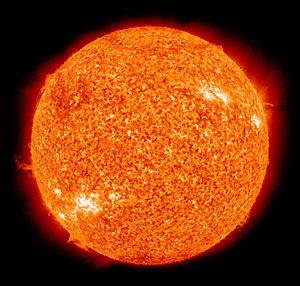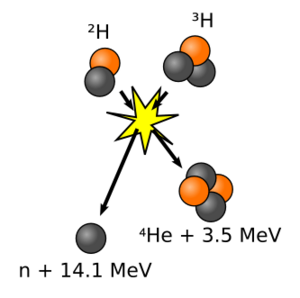Nuclear fusion facts for kids

Nuclear fusion is a powerful process. It happens when two light nuclei (the centers of atoms) join together. They form a single, heavier nucleus. This joining is a type of nuclear reaction. It releases a huge amount of energy.
The new nucleus created by fusion is heavier than each starting nucleus. But it's not as heavy as adding their original masses together. Some of that original mass seems to disappear. This "lost" mass actually turns into a lot of energy. This idea comes from Albert Einstein's famous equation, E=mc2.
Contents
Where Does Fusion Happen?
Nuclear fusion happens naturally in the middle of stars. Our own Sun is a great example. Inside the Sun, hydrogen atoms are constantly fusing. They combine to make helium. This process releases a massive amount of energy. This energy is what gives the Sun its heat and light.
Not all elements can join together easily. Lighter elements are much easier to fuse than heavier ones. For example, iron (a metal) cannot fuse with other atoms. This is why stars eventually "die." Stars keep fusing lighter atoms into heavier ones. They do this until they start making iron. Once a star makes iron, the fusion reactions stop. The star then cools down and eventually ends its life cycle.
Why Is Fusion Hard to Create on Earth?
It is very difficult to start nuclear fusion reactions on Earth. Even harder is making them release more energy than we use to start them. Fusion reactions need extremely high temperatures and pressures. These conditions are similar to those found inside the Sun.
The main challenge is that all nuclei have a positive charge. Positive charges naturally push away from each other. To make them fuse, we need to make the nuclei hit each other at incredibly high speeds. This only happens at very high temperatures and pressures.
So far, the only successful way to create fusion on Earth has been in certain nuclear weapons. These weapons use a smaller atomic (fission) bomb to create the extreme conditions needed to start fusion.
The Future of Fusion Power
Scientists and engineers have been working for many years. They want to find a safe way to control fusion reactions. Their goal is to use fusion to generate electricity. This would be a very clean source of energy. However, there are still many challenges to overcome. We are still working towards a future where fusion power can be used for our homes and cities.
Images for kids
See also
 In Spanish: Fusión nuclear para niños
In Spanish: Fusión nuclear para niños



